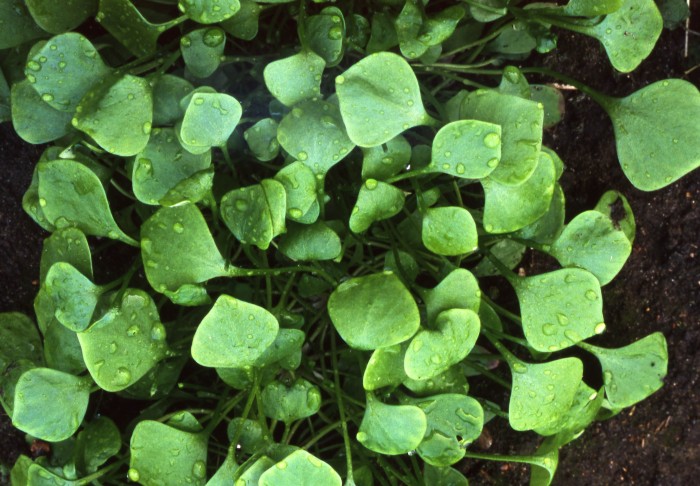Claytonia / Montia perfoliata, Cuban Spinach, Miner’s Lettuce Almost every greenhouse should have some of this low growing ground covering salad plant closely related to Purslane. Not as an ornamental feature necessarily but for it’s fantastic utility. You see this little grown annual, Claytonia perfoliata, Cuban spinach or Miner’s Lettuce hails from the central Americas and has an unusual habit.

It self seeds prolifically and successfully, so densely it excludes all else, yet seldom does it become a problem for it dislikes hot dry conditions thriving only when it’s cool and damp. Once sown (simply scatter the tiny black seeds where you want them to grow anytime from early autumn on). Soon you have a lush green carpet throughout winter with it all disappearing by early summer, only to magically reappear as the nights draw in again.
It’s remarkably easy to weed out if it does get in the wrong place as it does not re-grow. Thus Claytonia makes a fantastic catch crop or green manure for winter when little else will. You can either incorporate it in situ by digging it under or very easily strip it off to compost and return. Either way Claytonia improves the soil leaving a fibrous matt of tiny rootlets which soon decay.
The lush growth in winter alone makes it a useful greenhouse plant for either embellishing or enriching borders and it’s very attractive grown as ‘ground cover’ in the compost of bigger plants in tubs such as citrus where it excludes all else and keeps the compost surface moist. Best of all it’s a fantastic salad crop, succulent, never getting bitter nor hot not even when flowering with tiny white flowers. Claytonia can even be grown outdoors as it is remarkably hardy however it’s indoor plants that are best for salad.
Children eat this salad leaf avidly and much in preference to lettuce! As do hens- thus it’s a good green winter fodder for chickens and most cage birds. Cuban spinach as the name suggests means it’s also enjoyed as spinach. The whole plant nipped off just above it’s root, chopped and steamed, leaves and stalks together, soon breaks down and with butter, pepper and salt makes a most nutritious dark green dish. However it is raw as a winter salad this excels.
Other members of the family are also edible with C. exigua once popular as a potherb in California. C. sibirica is likewise eaten raw and cooked, not quite as palatable but it does have larger attractive pink flowers. Of interest to the curious gardening gourmet will be C. caroliniana, C. tuberosa and C. virginica which all produce edible bulbs once much prized by native Americans. A small point- do not confuse Claytonia with Claydonia, that’s Reindeer Moss, a lichen, and although edible in desperation is far from being delicious, succulent or even palatable.










